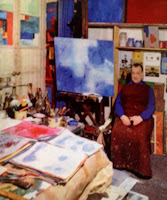So now we are back at the beginning. However, I do suggest for those who may have not read chapters 1 on "Like Winning the Lottery" and 2," In Between Two Worlds," do so as it certainly indicates the diversity of the two exhibitions and now Serge Poliokoff . And perhaps read my chapter on Serge Poliakoff of the 14th October. It's the second part .
http://discovmaggsie.blogspot.com/2013/10/dreams-as-centuries-go-and-music-to-come.html

I don’t really think that I can add too much to what I have already written.
However, I will try. Here he is though in his studio in 1963
The first exhibition was of water colours. Now «
The Dream of Forms, the viewing itinerary ». Over 70 paintings. The title left me a little perplexed and then of course I understood that we would be tracing his different periods from 1946 through to 1969. There were ten but I am not going to give descriptives of each one.
Why do I like Serge Poliakoff so much? His geometric forms are silent. There is nothing busy about them at all.
 |
| Fond Orange 1951 |
 |
| Composition abstraite 1953 |
But this time around I really was surprised by a period I didn’t know at all. He calls it his
« Transparency period ». Pollock? It was a diptych so this is just one side of it. The influence seems to be obvious and yet the painting in the same room from same period is so different from his geometric forms. Once again it is something else. This was done in 1958.
 |
| Diptyque 1961 - Influenced by Pollack? |
 |
| Rose et Lie de Vin 1958 |
He’s exploring. When he outlines his forms, I am not so keen on the work. Somehow they lose their freedom. But when you see something like this where a dog jumps at you or a human being, the Poliakoff I like so much comes back into his real world - for me anyway.
 |
| FORME BLEUE 1951 |
But this left me in a dazed state. It's a mural composition painted between 1965 and 1967. There are 13 panels. Apart from the fact it is an unusual set up, you would think that it is practically a religious form. The sun at that moment poured in on the painting and every colour jumped into perspective. Quite extraordinary.
 |
| MURAL COMPOSITION 1965-67 |
 |
| Triptyque 1968 |
At the end of his life the forms are simplified down to an often binary
form placed in the centre of the picture and set off by a sober
background. They are monumental paintings too and alas, when I was busy
taking photos, I got wrapped over the nuckles yet again. A young man
(you see him below) had taken photo after photo and yet I’m the one who
gets caught. Anything I
took was blurred an although perhaps a painting in itself, it had
nothing to do with Poliakoff.
 |
| Form 1968 |
 |
| The last period |
To sum all this up.
I believe Poliakoff was concerned with the relationship between line and surface, content and form, color and light. There is tension in his forms perhaps because of the juxtaposed color but even so, to my eye, they all balanced. The vibration becomes music to my ears.
 |
| Danse russe, étude de mouvement 1937 |
And just take a look at this. He too came a long way. A Russian dance which was a study for movement. Oh yes, this is music.















Commentaires